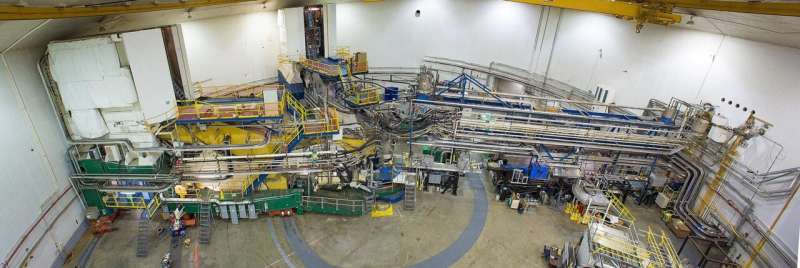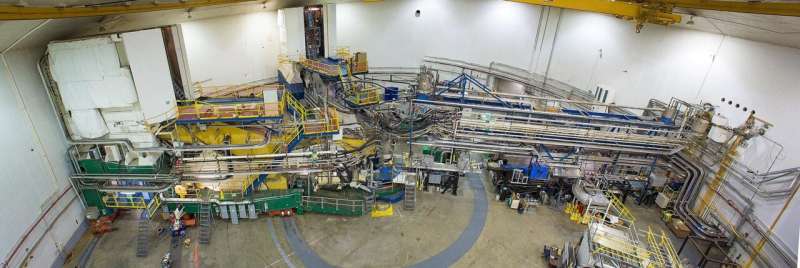Novel experiment measures neutron skin in calcium

A new high-precision measurement of the neutron skin in doubly magic calcium-48 may help shed light on proton-neutron interactions inside nuclei. This is the first highly robust electroweak measurement of the neutron skin in a medium-weight nucleus. The results from this new measurement, made by the 48Ca Radius EXperiment (CREX) collaboration at DOE's Thomas Jefferson National Accelerator Facility, will be presented at the 2021 Fall Meeting of the APS Division of Nuclear Physics.
"We're studying a particular neutron-rich nucleus called calcium-48. It's a special isotope of calcium that has an excess of neutrons. The nucleus is made of protons and neutrons, and calcium-48 has more neutrons than protons. We're trying to understand how they are distributed in this dense nucleus," says Caryn Palatchi, a research associate at the University of Virginia who will present the results.
In the most massive stable nucleus measured, lead-208, it was recently confirmed that relatively equal numbers of protons and neutrons congregate toward the core, while extra neutrons are pushed out to the fringe. Now, nuclear physicists are testing whether this holds true for the still densely populated but much-less-massive and stable calcium-48 nucleus.
"This particular isotope has an excess of neutrons and a density that is high. It's thought that the neutrons can spread out and extend further out than the protons to create this skin, a neutron skin, surrounding the nucleus of calcium. We're trying to measure this skin and how thick it is," Palatchi says.
The thickness of the neutron skin of lead-208 was found to be thicker than once thought, with implications not only for the structure of nuclei, but also for neutron stars. This new measurement of the neutron skin in calcium-48 will also have novel implications for nuclear physicists' understanding of the structure of nuclei.
"The smaller calcium nucleus has fewer protons and neutrons, and it's just within the reach of certain types of calculations that come from first principles, or ab initio calculations. Between the two different measurements, we can compare them against models that are ab initio calculations of nucleon-nucleon interactions and models that are for a uniform dense nucleus," Palatchi explains. "So, between the two experiments, you can talk about this landscape describing highly dense matter."
The experiment was carried out in the Continuous Electron Beam Accelerator Facility, a DOE scientific user facility. Data was taken December 2019 to March 2020 and July to September 2020. In the experiment, a beam of energetic electrons was directed into a silver-colored disk of pure calcium-48 that was shaped like a hockey puck—about the size of a half-dollar and a half-inch thick.

The energetic electrons interact with protons and neutrons inside the calcium nuclei via the electroweak force. While interactions via the electromagnetic part of the electroweak force are parity-conserving, interactions via the weak force part are parity-violating.
"Parity is a mirror symmetry. It refers to if you were to change the interaction from right to left and from up to down, the same result would occur," Palatchi explains. "Parity-violating means that there is an interaction that if you do a mirror image of it, it doesn't turn out the same; the mirror image isn't identical."
This parity violation characteristic allows the nuclear physicists to hone in on the electrons' interactions with neutrons inside the calcium-48 nucleus.
"Parity violation is a signature of the weak force, and neutrons have a weak charge. So, we are really probing the neutrons. We're using the weak force to probe them," Palatchi says.
The final result will provide information on calcium-48's form factor, its neutron skin and the neutron radius. The similar experimental conditions also allow for comparisons between calcium-48 and lead-208 nuclei.
"We expect to set a benchmark with this measurement. The neutron skin in lead came out thick relative to our expectations, so we expect the same with calcium," says Robert Michaels, a staff scientist at Jefferson Lab who will also present the results with further discussion. "Either way, we expect this result to tell us something new about the structure of dense nuclei."
The first public presentation of the 48Ca Radius EXperiment (CREX) result will be made by Caryn Palatchi, a research associate at the University of Virginia. She'll present the first results from CREX at the 2021 Fall Meeting of the APS Division of Nuclear Physics. Robert Michaels, a staff scientist at Jefferson Lab, will also present the results with further discussion. The meeting is being held virtually October 11-14.
More information: The team will take questions at a live virtual news briefing on October 12 at 10:00 a.m. EDT.
Provided by American Physical Society




















